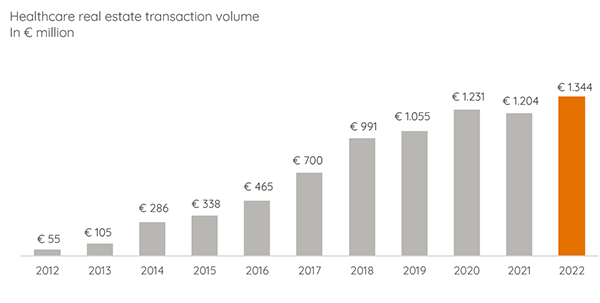Investments in healthcare real estate reach record high in 2022
11 januari 2023
Despite the challenges in the real estate market, 2022 again proved a strong year for the healthcare real estate asset class. Research by property consultant Capital Value shows that investments in healthcare real estate totalled more than €1.3 billion, establishing a new record in the healthcare real estate market. The fact that the transaction volume has exceeded €1 billion four years running underlines the market's financial stability, even in less favourable economic times. By far the largest portion of the transaction volume comprised care homes (88%); the remainder consisted of first- and second-line healthcare property. The proportion of new-build transactions remained stable. This requires attention, as the market faces an immense need for new build healthcare real estate.

Institutional investors dominate
Dutch investors were responsible for the lion's share of the transaction volume (71%). Institutional investors were able to realise various large-scale transactions in 2022, investing a total of €482 million, 85% more than in 2021. A noteworthy transaction was the LUXOR-I portfolio, comprising 32 private residential care properties belonging to Dagelijks Leven and spread across the Netherlands. Syntrus Achmea acquired the portfolio from the international listed care company Orpea, on behalf of Achmea Dutch Healthcare Property Fund. Due to financial circumstances, Orpea chose to sell part of its portfolio through a sale and leaseback transaction. Another major transaction was the purchase of 144 intramural care units and 149 units of sheltered housing for the Bouwinvest Healthcare Fund in The Hague.
Interest rate increase makes itself felt in latter six months
Dutch investors took advantage of the gap created by the increased interest rate for bank financing. Because of this rate increase, investors dependent on foreign capital and international investors were less active in the healthcare real estate market in the second half of 2022. Low stock prices also hindered acquisitions by listed investors in healthcare real estate. The interest rate increase resulted in rising prime returns in the final quarter of 2022. Expectations are that the current uncertain market situation will cause fewer new investors to enter the Dutch market. Instead, various established real estate investors are employing strategies focused on high-quality, sustainable real estate, strong operators and good locations.
Number of transactions decreasing
Despite the stable transaction volume in recent years, the number of transactions fell by 20% over the past two years. This became particularly visible towards the end of 2022. A total of 20 transactions were realised in the final quarter of 2022, compared to 40 in 2021 and 71 in 2020. Conversely, the average transaction volume has grown. The average investment per transaction in 2022 was €10.9 million; in 2020, this was €8 million per transaction. In 2022, nearly 90% of all transactions involved an investment of €20 million or less, together accounting for approximately half of the transaction volume. In addition, as is the case every year, there were a number of large portfolio transactions. The year 2022 saw nine transactions exceeding €30 million, which together amounted to more than 43% of the total transaction volume.
Less new build despite severe shortages
The need for care homes remains undiminished. Figures from the National Health Care Institute show that the number of senior citizens registered on waiting lists for immediate admission to a nursing home increased by 70% in 2022, reaching a total of 4,737 persons. The transaction figures show no sign of the necessary increase in new-build output and transformations. In fact, the number of new-build transactions in the healthcare real estate market fell slightly. The volume shows only a minor increase of 2% compared to 2021. The feasibility of new-build projects in healthcare real estate was constrained further due to a confluence of various market developments. One important element are the construction costs, which rose further in 2022. Additionally, the rate increase put an end to the falling initial yields. The announced reduction in NHC fees added to the strain on income from housing, and various healthcare new-build projects have been cancelled or put on hold.
Still, pushing on with new-build production is essential right now, says Manon Kuipers, director of healthcare real estate at Capital Value. "Healthcare institutions are seeing their capacity dwindle due to delays in new-build projects and staff shortages, while waiting lists continue to grow. New healthcare properties and smart buildings present opportunities to increase efficiency in the healthcare sector through floor plan adjustments, hybrid buildings and new technologies in the field of domotics, among others. Sustainability is also becoming an important focus in the healthcare sector, also for investors and housing associations when making acquisitions. As such, there is increasing common ground between healthcare institutions and market parties that motivates a focus on a future-proof supply."


